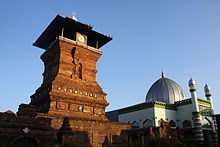Legacy

Pura Maospahit ("Majapahit Temple") in Denpasar, Bali, demonstrate the typical Majapahit red brick architecture.
Numbers of local legends and folklores in the region had mentioned about the Majapahit kingdom. Most of them mentioned about the incoming Javanese forces to their land, which was probably a local testament of the empire's expansive nature that once dominating the archipelago. The legend of Minangkabau mentioned an invading foreign prince — associated with Javanese Majapahit kingdom — that being defeated on buffalo fight. Others than Javanese sources, some regional legends mentioning Majapahit kingdom or its general Gajah Mada, also can be found; from Aceh, Minangkabau, Palembang, Malay Peninsula, Sunda, Brunei, Bali to Sumbawa.
Several Javanese legends were originated or become popular during Majapahit period. The Panji cycles, the tale of Sri Tanjung, and the epic of Damarwulan, are popular tales in Javanese and Balinese literatures. The tales of Panji was dated from older period during Kediri kingdom, while the tale of Sri Tanjung and the epic of Damarwulan took place during Majapahit period. These tales has remain a popular theme in Javanese culture of later period during Mataram Sultanate, and often become the source of inspiration for wayang shadow puppet performance, ketoprak and topeng dance drama.
Majapahit had a momentous and lasting influence on Indonesian architecture. The descriptions of the architecture of the capital's pavilions (pendopo) in the Nagarakertagama invoke the Javanese Kraton also the Balinese temples and palace compounds of today. The Majapahit architectural style that often employs terracotta and red brick had heavily influenced the architecture of Java and Bali in the later period. The Majapahit style candi bentar split gate, the kori or paduraksa towering red brick gate, and also pendopo pavilion has become ubiquitous in Javanese and Balinese architectural features, as evidence in Menara Kudus Mosque, Keraton Kasepuhan and Sunyaragi park in Cirebon, Mataram Sultanate royal cemetery in Kota Gede, Yogyakarta, and various palaces and temples in Bali.

The red brick Candi Bentar split gate of Keraton Kasepuhan in Cirebon reveal Majapahit architectural influences.
In weaponry, the Majapahit expansion is believed to be responsible for the widespread use of the keris dagger in Southeast Asia; from Java, Bali, Sumatra, Malaysia, Brunei, Southern Thailand, to the Philippines. Although it has been suggested that the keris, and native daggers similar to it, predate Majapahit, nevertheless the empire expansion contributed to its popularity and diffussion in the region.
For Indonesians in later centuries, Majapahit became a symbol of past greatness. The Islamic sultanates of Demak, Pajang, and Mataram sought to establish their legitimacy in relation to the Majapahit.[33] The Demak claimed a line of succession through Kertabumi, as its founder, Raden Patah, in court chronicles was said to be the son of Kertabumi with Putri Cina, a Chinese princess, who had been sent away before her son was born.[22] Sultan Agung's conquest of Wirasaba (present day Mojoagung) in 1615 — during that time just a small town without significant strategic and economic value — led by the sultan himself, may probably have had such symbolic importance as it was the location of the former Majapahit capital.[34] Central Javanese palaces have traditions and genealogy that attempt to prove links back to the Majapahit royal lines — usually in the form of a grave as a vital link in Java — where legitimacy is enhanced by such a connection.[citation needed] Bali in particular was heavily influenced by Majapahit and the Balinese consider themselves to be the true heirs of the kingdom.[25]

The high reliefs of Gajah Mada and Majapahit history depicted in Monas, has become the source of Indonesian national pride of past greatness.
The Indonesian coat of arms, Garuda Pancasila, also derives from Javanese Hindu elements.[36] The statue and relief of Garuda have been found in many temples in Java such as Prambanan from the ancient Mataram era, and the Panataran as well as the Sukuh temple dated from the Majapahit era. The notable statue of Garuda is the statue of the king Airlangga depicted as Vishnu riding Garuda.
In its propaganda from the 1920s, the Communist Party of Indonesia presented its vision of a classless society as a reincarnation of a romanticized Majapahit.[37] It was invoked by Sukarno for nation building and by the New Order as an expression of state expansion and consolidation.[38] Like Majapahit, the modern state of Indonesia covers vast territory and is politically centred on Java.
Palapa, the series of communication satellites owned by Telkom, an Indonesian telecommunication company, has been named after Sumpah Palapa, the famous oath taken by Gajah Mada. Gajah Mada swore that he would not taste any spice as long as he had not succeeded in unifying Nusantara (Indonesian archipelago). This ancient oath of unification signifies the Palapa satellite as the modern means to unify the Indonesian archipelago by way of telecommunication. The name was chosen by president Suharto, and the program was started in February 1975.
During the last half year of 2008, the Indonesian government sponsored a massive exploration on the site that is believed to be the place where the palace of Majapahit once stood. Jero Wacik, the Indonesian Minister of Culture and Tourism stated that the Majapahit Park would be built on the site and completed as early as 2009, in order to prevent further damage caused by home-made brick industries that develop on the surrounding area.[39] Nevertheless, the project leaves a huge attention to some historians, since constructing the park's foundation in Segaran site located in south side of Trowulan Museum will inevitably damage the site itself. Ancient bricks which are historically valuable were found scattered on the site. The government then argued that the method they were applying were less destructive since digging method were used instead of drilling.[40]


Tidak ada komentar:
Posting Komentar